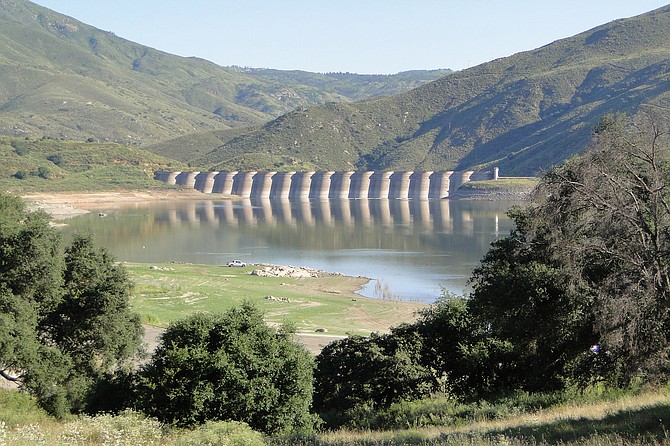 Facebook
Facebook
 X
X
 Instagram
Instagram
 TikTok
TikTok
 Youtube
Youtube

Starting from the parking area closest to the restrooms, make your way up the road to the kiosk marking the beginning of the trail, a service road that runs along the south side of Lake Sutherland. The lake — or the dry lakebed, due to the low water level being maintained — is visible most of the time. The habitat varies from chaparral to oak woodland. Coast live oaks (Quercus agrifolia) provide intermittent shade all along the route.
From the kiosk area, you have a nice view of the Lake Sutherland Dam, completed in 1954. The lake, one of 24 reservoirs that provide a component of the drinking water supply for the City of San Diego, is fed by Santa Ysabel Creek. It is a favorite of kayakers, boaters, and fishermen. In spite of its close proximity to Ramona, it feels very isolated, since no houses are in view.
The best time of year to visit is in the spring (March – June) when magnificent wildflower blooms are visible. Woodland stars, wide-throated yellow monkeyflowers, Parry’s phacelia, Chinese houses, chamise, hoary-leaf ceanothus, and many more are in abundance. Several species of lupine are present, along with heart-leaved penstemon. Bring your binoculars for viewing the wide variety of birds. California quail, California thrashers, scrub jays, and spotted towhees inhabit the chaparral and oak woodland areas. Western grebes, great blue herons, egrets, and a variety of ducks, and other waterfowl inhabit the waterway. The skies are filled with turkey vultures and raptors, including the occasional bald eagle. Turkey tracks are common.
Until very recently, signs for Camp Hope parking appeared alongside the road at several wide spots. Camp Hope America is a year-round camping and mentoring program for children and teens impacted by domestic violence. The organization operated a month-long summer camp at Lake Sutherland starting in 2003, before the wildfires of 2007 burned through the area.
Another interesting sight is that of horses grazing and frolicking along the lakeshore. They can be seen rolling in the sandy soil of the “beach” in an attempt to scratch their backs. While a Google search suggests these are ”wild” horses, that has not been confirmed. They most likely belong to ranchers in the area, but they may have escaped to breed on their own in the wild.
After about 1.7 miles, the roadway is blocked by a gate warning that what lies beyond is private property. Return to your vehicle by retracing your steps.



Starting from the parking area closest to the restrooms, make your way up the road to the kiosk marking the beginning of the trail, a service road that runs along the south side of Lake Sutherland. The lake — or the dry lakebed, due to the low water level being maintained — is visible most of the time. The habitat varies from chaparral to oak woodland. Coast live oaks (Quercus agrifolia) provide intermittent shade all along the route.
From the kiosk area, you have a nice view of the Lake Sutherland Dam, completed in 1954. The lake, one of 24 reservoirs that provide a component of the drinking water supply for the City of San Diego, is fed by Santa Ysabel Creek. It is a favorite of kayakers, boaters, and fishermen. In spite of its close proximity to Ramona, it feels very isolated, since no houses are in view.
The best time of year to visit is in the spring (March – June) when magnificent wildflower blooms are visible. Woodland stars, wide-throated yellow monkeyflowers, Parry’s phacelia, Chinese houses, chamise, hoary-leaf ceanothus, and many more are in abundance. Several species of lupine are present, along with heart-leaved penstemon. Bring your binoculars for viewing the wide variety of birds. California quail, California thrashers, scrub jays, and spotted towhees inhabit the chaparral and oak woodland areas. Western grebes, great blue herons, egrets, and a variety of ducks, and other waterfowl inhabit the waterway. The skies are filled with turkey vultures and raptors, including the occasional bald eagle. Turkey tracks are common.
Until very recently, signs for Camp Hope parking appeared alongside the road at several wide spots. Camp Hope America is a year-round camping and mentoring program for children and teens impacted by domestic violence. The organization operated a month-long summer camp at Lake Sutherland starting in 2003, before the wildfires of 2007 burned through the area.
Another interesting sight is that of horses grazing and frolicking along the lakeshore. They can be seen rolling in the sandy soil of the “beach” in an attempt to scratch their backs. While a Google search suggests these are ”wild” horses, that has not been confirmed. They most likely belong to ranchers in the area, but they may have escaped to breed on their own in the wild.
After about 1.7 miles, the roadway is blocked by a gate warning that what lies beyond is private property. Return to your vehicle by retracing your steps.
